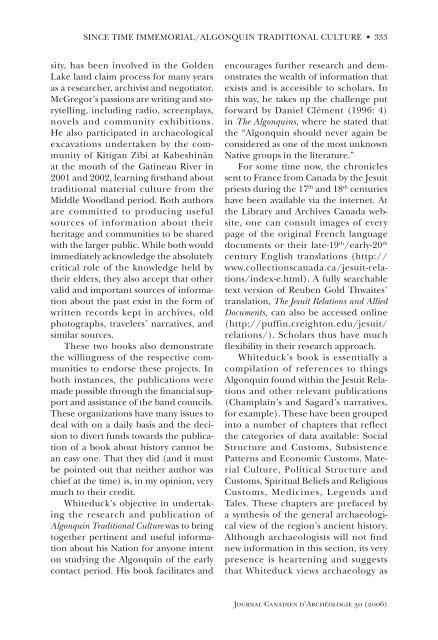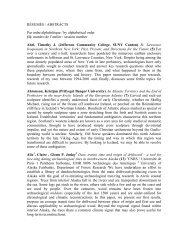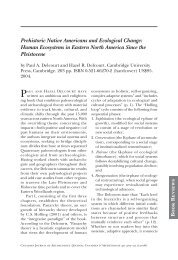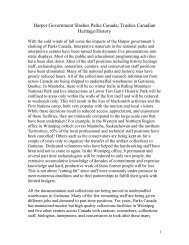Since Time Immemorial, “Our Story” - Canadian Archaeological ...
Since Time Immemorial, “Our Story” - Canadian Archaeological ...
Since Time Immemorial, “Our Story” - Canadian Archaeological ...
You also want an ePaper? Increase the reach of your titles
YUMPU automatically turns print PDFs into web optimized ePapers that Google loves.
<strong>Since</strong> <strong>Time</strong> <strong>Immemorial</strong>/Algonquin Traditional Culture • 333<br />
sity, has been involved in the Golden<br />
Lake land claim process for many years<br />
as a researcher, archivist and negotiator.<br />
McGregor’s passions are writing and storytelling,<br />
including radio, screenplays,<br />
novels and community exhibitions.<br />
He also participated in archaeological<br />
excavations undertaken by the community<br />
of Kitigan Zibi at Kabeshinàn<br />
at the mouth of the Gatineau River in<br />
2001 and 2002, learning firsthand about<br />
traditional material culture from the<br />
Middle Woodland period. Both authors<br />
are committed to producing useful<br />
sources of information about their<br />
heritage and communities to be shared<br />
with the larger public. While both would<br />
immediately acknowledge the absolutely<br />
critical role of the knowledge held by<br />
their elders, they also accept that other<br />
valid and important sources of information<br />
about the past exist in the form of<br />
written records kept in archives, old<br />
photographs, travelers’ narratives, and<br />
similar sources.<br />
These two books also demonstrate<br />
the willingness of the respective communities<br />
to endorse these projects. In<br />
both instances, the publications were<br />
made possible through the financial support<br />
and assistance of the band councils.<br />
These organizations have many issues to<br />
deal with on a daily basis and the decision<br />
to divert funds towards the publication<br />
of a book about history cannot be<br />
an easy one. That they did (and it must<br />
be pointed out that neither author was<br />
chief at the time) is, in my opinion, very<br />
much to their credit.<br />
Whiteduck’s objective in undertaking<br />
the research and publication of<br />
Algonquin Traditional Culture was to bring<br />
together pertinent and useful information<br />
about his Nation for anyone intent<br />
on studying the Algonquin of the early<br />
contact period. His book facilitates and<br />
encourages further research and demonstrates<br />
the wealth of information that<br />
exists and is accessible to scholars. In<br />
this way, he takes up the challenge put<br />
forward by Daniel Clément (1996: 4)<br />
in The Algonquins, where he stated that<br />
the “Algonquin should never again be<br />
considered as one of the most unknown<br />
Native groups in the literature.”<br />
For some time now, the chronicles<br />
sent to France from Canada by the Jesuit<br />
priests during the 17 th and 18 th centuries<br />
have been available via the internet. At<br />
the Library and Archives Canada website,<br />
one can consult images of every<br />
page of the original French language<br />
documents or their late-19 th /early-20 th<br />
century English translations (http://<br />
www.collectionscanada.ca/jesuit-relations/index-e.html).<br />
A fully searchable<br />
text version of Reuben Gold Thwaites’<br />
translation, The Jesuit Relations and Allied<br />
Documents, can also be accessed online<br />
(http://puffin.creighton.edu/jesuit/<br />
relations/). Scholars thus have much<br />
flexibility in their research approach.<br />
Whiteduck’s book is essentially a<br />
compilation of references to things<br />
Algonquin found within the Jesuit Relations<br />
and other relevant publications<br />
(Champlain’s and Sagard’s narratives,<br />
for example). These have been grouped<br />
into a number of chapters that reflect<br />
the categories of data available: Social<br />
Structure and Customs, Subsistence<br />
Patterns and Economic Customs, Material<br />
Culture, Political Structure and<br />
Customs, Spiritual Beliefs and Religious<br />
Customs, Medicines, Legends and<br />
Tales. These chapters are prefaced by<br />
a synthesis of the general archaeological<br />
view of the region’s ancient history.<br />
Although archaeologists will not find<br />
new information in this section, its very<br />
presence is heartening and suggests<br />
that Whiteduck views archaeology as<br />
Journal Canadien d’Archéologie 30 (2006)








